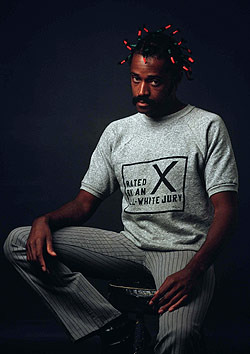Film Synopsis

Most of those familiar with Melvin Van Peebles know him as the driving force behind the incendiary 1971 film
Sweet Sweetback's Baadasssss Song.
While that revolutionary picture earned Van Peebles the title
"godfather of modern black cinema," the film's impact extends far beyond
blaxploitation genre conventions—Sweetback has proven to be a landmark
in both American and independent cinema. Much like the film's
iconoclastic hero (played by Van Peebles himself), a street-smart
hustler who single-handedly topples the white Establishment (a.k.a. the
Man!), Van Peebles functioned as a virtual one-man studio to make
Sweetback. Besides starring in the title role, Van Peebles financed,
produced, wrote, directed and scored the picture, which grossed more
than $10 million, making it the most successful independent film of its
time.
What few realize, however, is that
filmmaking is but a small part of Van Peebles' remarkable life. The same
dogged, DIY persistence that enabled Van Peebles to make
Sweetback
is evident in every project he undertakes, artistic or otherwise, and
his achievements have in turn inspired legions of like-minded creators,
from rap pioneer Gil Scott-Heron to filmmaker Spike Lee. Naturally, by
insisting on doing things his way, Van Peebles has stepped on some toes,
yet he consistently refuses to back down.
"My politics is to win," Van Peebles declares at the beginning of
How to Eat Your Watermelon in White Company (and Enjoy It),
a documentary that explores the life and work of this maverick,
modern-day Renaissance man. Whether making guerrilla-style films, flying
Air Force sorties over the Pacific (ferrying the atom bomb, no less),
studying astronomy in Amsterdam, writing novels in self-taught French,
composing music (by means of a self-devised notation system), writing
musical stage plays (for which he received nine Tony nominations),
recording seminal rap albums or trading options on Wall Street, Van
Peebles has blazed his own path, making a mark in each endeavor he's
pursued.
In
How to Eat Your Watermelon…
the events of Van Peebles' life are vividly recounted through
interviews with colleagues, contemporaries, critics, family and friends.
The film also takes advantage of remarkable archival footage culled
from all corners of Van Peebles' diverse life—ranging from rare
interviews on French TV to a hilarious series of opinion pieces culled
from his brief foray as a financial-news analyst—to paint a sharp
portrait of this unique personality. But
How to Eat Your Watermelon…
doesn't merely enumerate Melvin Van Peebles' artistic glories, nor does
it plot a static hagiography of accomplishments; by virtue of original
cinema vérité footage shot over the past eight years in the U.S. and
France, it constructs a gripping narrative of a restless artist in an
often unforgiving world, and reveals that Van Peebles, at age 74, is
still a vital creative force who shows no signs of slowing down.
How to Eat Your Watermelon…
is structured as a conversation, in which an improbably varied cast of
characters weaves together a story that constantly builds in intensity
and surprise. It's as if they can't all be talking about the same
person, yet in the absence of a narrator, the audience is repeatedly
left to wonder how such dramatic plot turns in the story of one man can
be possible. First he's a grip man on a San Francisco cable car, next
he's writing a book about working on a cable car; then he's an
astronomer in Amsterdam before teaching himself French and publishing
five French novels; before long he's the director of the official French
entry in an American film festival—and eventually authoring a book on
how to trade stock options on Wall Street. All of these disparate
moments coalesce into a story that is nothing short of astonishing. The
film comes together gradually as it introduces the "connective tissue"
of each episode in Van Peebles' life: His comfort with the unknown; his
ability to create his own working system out of complexities ranging
from musical notation to financial analysis; his boundless determination
to say something important no matter what the vehicle of expression;
his artistic "jujitsu," by which he confronts the Establishment by using
its power against itself.
As the story
unfolds, a visual mystery is played out as well. At the film's
beginning, we see an unidentified man, his head encased in a massive
blue bubble of polyurethane. As the events of Van Peebles's career
unfold, the film periodically returns to two sculptors who are creating a
lifelike figure of Melvin for part of an art exhibition paying tribute
to blaxploitation cinema. The creation of the sculpture functions as the
film's narrative spine—a vivid metaphorical transitional device linking
the distinct chapters in Van Peebles's life and career.
One of the central themes of
How to Eat Your Watermelon…
is that determination (coupled with talent) trumps adversity every
time. As an African-American artist, Van Peebles puts forth a powerful
notion about how the battle for true racial equality should unfold, were
it to be honest and sincere. In his song "Just Don't Make No Sense,"
Van Peebles takes aim at the presumptions black men in America must face
every day: "Frown, you hostile / Smile, you a Tom / Look tired, you on
junk / Stumble, you drunk." Van Peebles typically uses humor to convey
his themes, as when he tells the story of how he would spray his office
with a watermelon-scented fragrance just before the arrival of "liberal"
friends: "They would walk into the office and say, ‘Gee, Mel, what's
that smell? It smells like umm…umm…cantaloupe!' They were too afraid to
say watermelon!"
Humorous, serious and incisive,
How to Eat Your Watermelon in White Company (and Enjoy It) is ultimately a story about the power of fearlessness.

 Most of those familiar with Melvin Van Peebles know him as the driving force behind the incendiary 1971 film Sweet Sweetback's Baadasssss Song.
While that revolutionary picture earned Van Peebles the title
"godfather of modern black cinema," the film's impact extends far beyond
blaxploitation genre conventions—Sweetback has proven to be a landmark
in both American and independent cinema. Much like the film's
iconoclastic hero (played by Van Peebles himself), a street-smart
hustler who single-handedly topples the white Establishment (a.k.a. the
Man!), Van Peebles functioned as a virtual one-man studio to make
Sweetback. Besides starring in the title role, Van Peebles financed,
produced, wrote, directed and scored the picture, which grossed more
than $10 million, making it the most successful independent film of its
time.
Most of those familiar with Melvin Van Peebles know him as the driving force behind the incendiary 1971 film Sweet Sweetback's Baadasssss Song.
While that revolutionary picture earned Van Peebles the title
"godfather of modern black cinema," the film's impact extends far beyond
blaxploitation genre conventions—Sweetback has proven to be a landmark
in both American and independent cinema. Much like the film's
iconoclastic hero (played by Van Peebles himself), a street-smart
hustler who single-handedly topples the white Establishment (a.k.a. the
Man!), Van Peebles functioned as a virtual one-man studio to make
Sweetback. Besides starring in the title role, Van Peebles financed,
produced, wrote, directed and scored the picture, which grossed more
than $10 million, making it the most successful independent film of its
time.